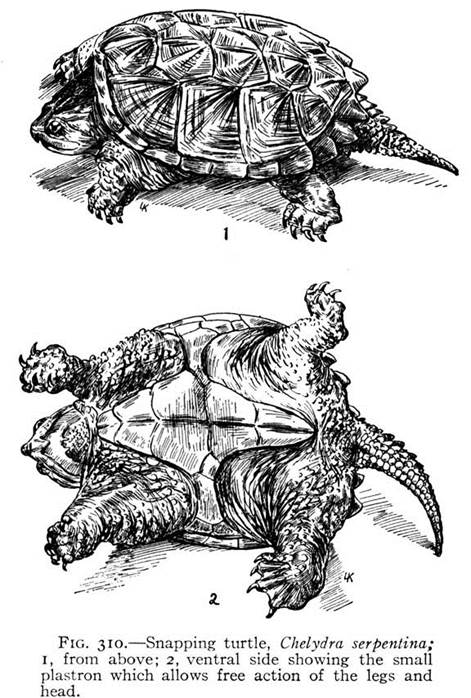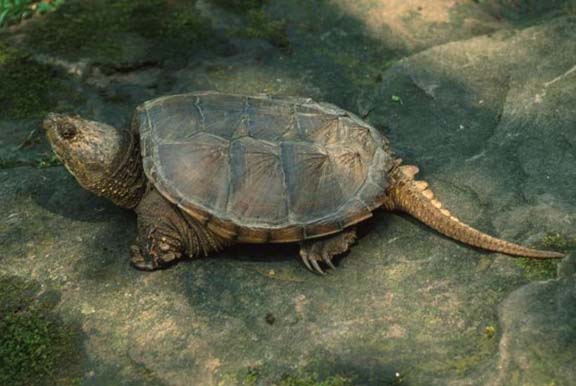“Dill said striking a match under a turtle was hateful.”
“Ain’t hateful, just persuades him- ‘s not like you’d chunk him in the fire,” Jem growled.
“How do you know a match don’t hurt him?”
“Turtles can’t feel , stupid,” said Jem.
“Were you ever a turtle, huh?”
– Harper Lee, To Kill a Mockingbird
This is a large freshwater turtle with a range that extends throughout the east coast from southeast Canada to the Rocky Mountains and from Nova Scotia to Florida. They are known for their belligerent disposition and tendency to bite with their sharp beak and powerful jaws. They are rugged, strong, and rather primitive looking creatures with a ridged carapace that is more pronounced on the young turtles. They are generally 9 – 18 inches long and weigh 10-35 pounds. The record is 75 pounds. They become sexually mature at 15-20 years old though it appears those in the southeast U.S. gain maturity a bit faster at around 12 years of age. They can live over 100 years.
This turtle can be found in slow moving streams, ponds, and even upper portions of estuaries. They like to bask by floating on the water surface with their nose above the surface appearing quite inconspicuous. In early spring they have been observed basking on logs but they don’t do this as often as other aquatic turtles. Other times they just lollygag on the muddy bottom of a pond and stretch up their long neck once in a while for a breath. There is some thought in the taxonomic circles that snapping turtles developed their nasty disposition and strong jaws because they cannot retreat into their shells for protection as most turtles can. Their plastron (underside) is quite reduced and doesn’t protect much.

They consume plant and animal matter, live or carrion and are opportunistic feeders and will eat a variety of fish, invertebrates, frogs, reptiles, and yes, even ducklings. Because of their size and disposition the adults have no predators but young will be taken by raccoons, otters, large fish, herons, snakes, and bullfrogs, among others. Eggs will be preyed upon crows and a number of medium sized mammals. The adults are commonly used for soup, particularly in the SE U.S.
They will mate from April to November, depending on location, with mid-summer being the height of egg laying. The female has the ability to hold sperm over several seasons, using it as needed. The females will travel across land looking for soil that is easily worked and sandy where she will lay 20-80 eggs. The eggs hatch in about 9-18 weeks and in the more northerly reaches of the range will overwinter and hatch the following spring – ensuring that the young emerge at a time that increases their survival.
These animals are quite fierce and have a surprisingly long neck so they can reach back over their shell to their rear feet and surprise someone attempting to pick them up. Chelydra –Greek for turtle, tortoise, water serpent. Serpentina – Greek for their snake-like neck. https://www.youtube.com/watch?v=GO1HD3ebuZs
I used to run into these critters quite a bit when I was young and living in N.J. My parents would drop us off at a rural pond nearby and we’d stay out of their hair and fish all day. One time a parent was there with several of their kids fishing for bluegills and bass like us. His young girl, maybe around 8 or so hooked a small snapping turtle, maybe a foot long and while Dad was occupied with one of the other kids she landed it and ventured too close. It snapped and latched on to her thumb with a vice grip. She got everyone’s attention within a half mile with her scream, Dad came running over and quickly decapitated the turtle with a Bowie knife as if it were cutting through butter. It still took him two hands to pry open the mouth. Ouch, ouch, ouch! Our eyes were as big as saucers and we were stunned.
But somehow this traumatic experience didn’t take root, or I just got stupider in my early teens. A few of us would routinely go hunting for big snappers by wadding barefoot through the shallow, muddy end of the pond or the nearby river, using sticks to probe for them. Once found you had to determine which was the business end of the turtle, find their tail, and drag them to shore where we would sell them to the African American guys fishing nearby for $5 or so. Their necks are so long and flexible that they can just about bite you while you pull on their shell at the base of the tail. Thus the only safe way to grab them is by the tail. We used to hold smaller ones at arm’s length so they didn’t latch onto our leg – though apparently herpetologist don’t recommend this as you could hurt their tail vertebrae – but I don’t know how else you would handle them.
I’m not clear how or why, but snapping turtles have been introduced outside of their range all over the western US. They have been found in Green Lake in the middle of Seattle and in the larger Lake Washington. Here’s an image for coloring while you are pondering some creative task.

